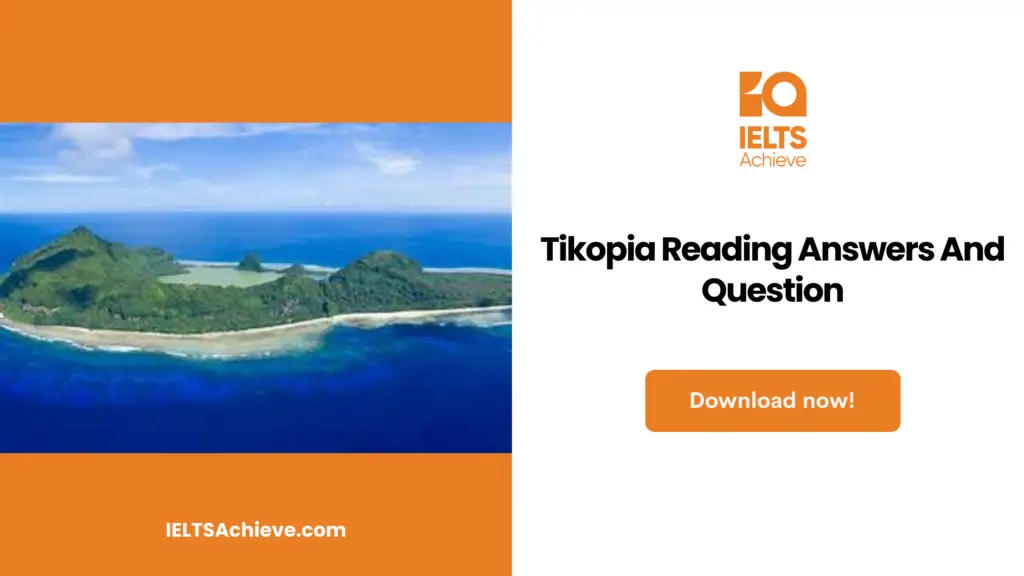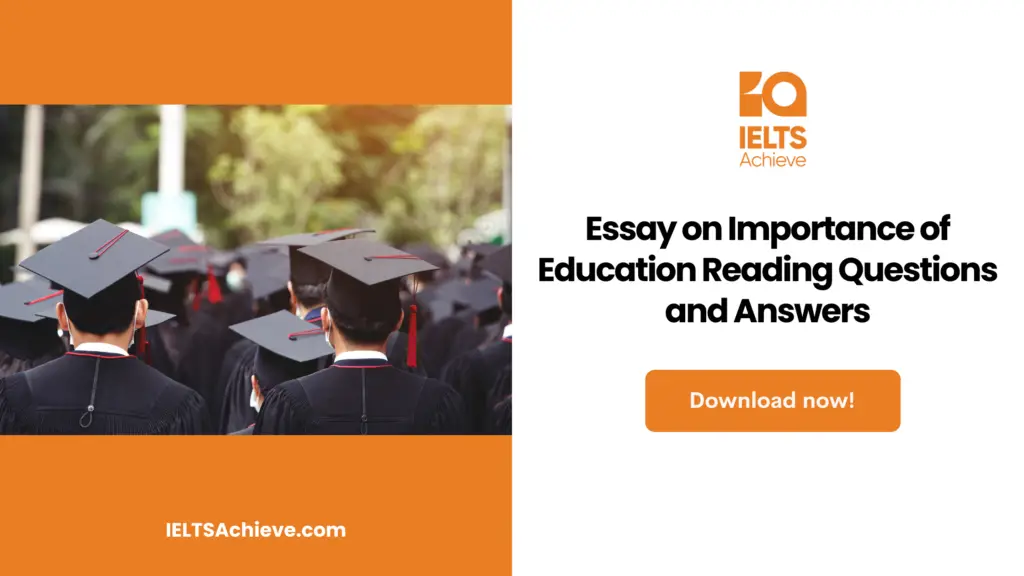The Blog post contains the following IELTS Reading Questions:
- IELTS reading Diagram Labelling
- IELTS reading yes/no/not given
- IELTS reading Note Completion
Stay informed and prepared for success – Explore our comprehensive Reading Test Info page to get valuable insights, exam format details, and expert tips for mastering the IELTS Reading section.
IELTS reading passage – Tikopia

Tikopia
A. There are still debates about the origins of Polynesian culture, but one thing we can ensure is that Polynesia is not a single tribe but a complex one. Polynesians which include Marquesans, Samoans, Niueans, Tongans, Cook Islanders, Hawaiians, Tahitians, and Maori, are genetically linked to indigenous peoples of parts of Southeast Asia. It’s a subregion of Oceania, comprising a large grouping of over 1,000 islands scattered over the central and southern Pacific Ocean, within a triangle that has New Zealand, Hawaii and Easter Island as its corners.
B. Polynesian history has fascinated the western world since Pacific cultures were first contacted by European explorers in the late 18th century. The small island of Tikopia, for many people – even for many Solomon Islanders – is so far away that it seems like a mythical land; a place like Narnia, that magical land in C. S. Lewis’s classic, ‘The Chronicles of Narnia’. Maybe because of it – Tikopia, its people, and their cultures have long fascinated scholars, travellers, and casual observers. Like the pioneers’ Peter Dillion, Dumont D’Urville and John Coleridge Patterson who visit and write about the island in the 1800s, Raymond Firth is one of those people captured by the alluring attraction of Tikopia. As a result, he had made a number of trips to the island since the 1920s and recorded his experiences, observations, and reflections on Tikopia, its people, cultures and the changes that have occurred.
C. While engaged in the study of the kinship and religious life of the people of Tikopia, Firth made a few observations on their tattooing. Brief though these notes are, they may be worth putting on record as an indication of the sociological setting of the practice in this primitive Polynesian community. The origin of the English word ‘tattoo’ actually comes from the Tikopia word ‘tatau’. The word for tattoo marks, in general, is tau, and the operation of tattooing is known as ta tau, ta being the generic term for the act of striking.
D. The technique of tattooing was similar through Polynesia. Traditional tattoo artists create their indelible tattoos using pigment made from the candlenut or kukui nut. First, they burn the nut inside a bowl made of half a coconut shell. They then scrape out the soot and use a pestle to mix it with liquid. Bluing is sometimes added to counteract the reddish hue of the carbon-based pigment. It also makes the outline of the inscribed designs bolder on the dark skin of tattooing subjects.
E. For the instruments used when tattooing, specialists used a range of chisels made from albatross wing bone which were hafted onto a handle which was made from the heartwood of the bush and struck with a mallet. The tattooer began by sketching with charcoal a design on the supine subject, whose skin at that location was stretched taut by one or more apprentices. The tattooer then dipped the appropriate points – either a single one or a whole comb – into the ink (usually contained in a coconut – shell cup) and tapped it into the subject’s skin, holding the blade handle in one hand and tapping it with the other. The blood that usually trickled from the punctures was wiped away either by the tattooer or his apprentice, the latter having also inevitably painful – a test of fortitude that tattooers sought to shorten by working as fast as possible. In fact, tattoos nearly always festered and often led to sickness – and in some cases death.
F. In ancient Polynesian society, nearly everyone was tattooed. It was an integral part of ancient culture and was much more than a body ornament. Tattooing indicated ones’ genealogy and/or rank in society. It was a sign of wealth, of strength and of the ability to endure pain. Those who went without them were seen as persons of lower social status. As such, chiefs and warriors generally had the most elaborate tattoos. Tattooing was generally begun at adolescence, and would often not be completed for a number of years. Receiving tattoos constituted an important milestone between childhood and adulthood, and was accompanied by many rites and rituals. Apart from signalling status and rank, another reason for the practice in traditional times was to make a person more attractive to the opposite sex.
G. The male facial tattoo is generally divided into eight sections of the face. The centre of the forehead designated a person’s general rank. The area around the brows designated his position. The area around the eyes and the nose designated his hapu, or sub-tribe rank. The area around the temples served to detail his signature. This signature was once memorised by tribal chief’s who used it when buying property, signing deeds, and officiating orders. The cheek area designated the nature of the person’s work. The chin area showed the person’s mana. Lastly, the jaw area designated a person’s birth status.
H. A person’s ancestry is indicated on each side of the face. The left side is generally the father’s side, and the right side is the mother’s. The manutahi design is worked on the men’s back. It consists of two vertical lines drawn down the spine, with short vertical lines between them. When a man had the manutahi on his back, he took pride in himself. At gatherings of the people he could stand forth in their midst and display his tattoo designs with songs. And rows of triangles designed on the men’s chest indicate his bravery.
I. Tattoo was a way of delivering information about its owner. It’s also a traditional method to fetch spiritual power, protection and strength. The Polynesians use this as a sign of character, position and levels in a hierarchy. Polynesian people believe that a person’s mana, their spiritual power or life force, is displayed through their tattoo.
Unlock your full potential in the IELTS Reading section – Visit our IELTS Reading Practice Question Answer page now!
Recommended Questions:
Renewable Energy IELTS Reading Question with Answer
Questions
Questions 1-4
Do the following statements agree with the information given in the Reading Passage? In boxes 1-4 on your answer sheet, write-
YES if the statement agrees with the information
NO if the statement contradicts the information
NOT GIVEN If there is no information on this
1. Scientists like to do research in Tikopia because this tiny place is of great remoteness.
2. Firth was the first scholar to study Tikopia.
3. Firth studied the culture differences on Tikopia as well as on some other islands of the Pacific.
4. The English word ‘tattoo’ evolved from the local language of the island.
Want to excel in identifying the writer’s views and claims? Click here to explore our in-depth guide on how to accurately determine Yes, No, or Not Given in the IELTS Reading section.
Questions 5-9
Label the diagram below. Choose NO MORE THAN TWO WORDS from Reading Passage for each answer. Write your answers on boxes 5-9 in your answer sheet.

Questions 10-14
Complete the notes below. Choose NO MORE THAN TWO WORDS from the passage for each answer. Write your answers on boxes 10-14 in your answer sheet.
Location On The Body: Significance
10. ___________ of male face: General tank
11. ___________ of male face: PrestigeFemale’s right side of the face: 12. ___________.
Location on the body: Significance : Geometric patterns
Male back : Sense of pride : 13. ___________.
Male chest : Bravery : 14 ___________.
Boost your performance in Summary, Notes, Table, and Flowchart Completion tasks. Click here to explore our detailed guide and learn how to effectively complete summaries, notes, tables, and flowcharts in the IELTS Reading section.
Unlock your full potential in the IELTS Reading section – Visit our IELTS Reading Practice Question Answer page now!
Recommended Questions:
Renewable Energy IELTS Reading Question with Answer
Answers for Tikopia
1. Answer: Yes
2. Answer: No.
3. Answer: Not Given
4. Answer: Yes
5. Answer: Coconut shell
6. Answer: Soot
7. Answer: Liquid
8. Answer: Hearwood
9. Answer: Wing bone
10. Answer: (the) Forehead
11. Answer: Chin (area)
12. Answer: Mother’s ancestry
13. Answer: Vertical lines
14. Answer: Triangles

We hope you found this post useful in helping you to study for the IELTS Test. If you have any questions please let us know in the comments below or on the Facebook page.
The best way to keep up to date with posts like this is to like us on Facebook, then follow us on Instagram and Pinterest. If you need help preparing for the IELTS Test, join the IELTS Achieve Academy and see how we can assist you to achieve your desired band score. We offer an essay correction service, mock exams and online courses.

